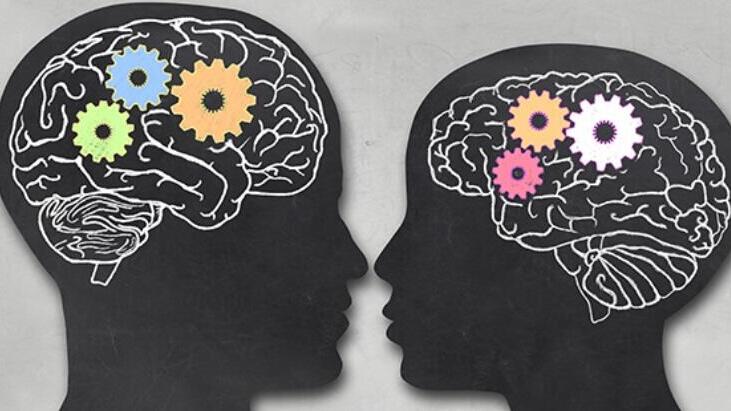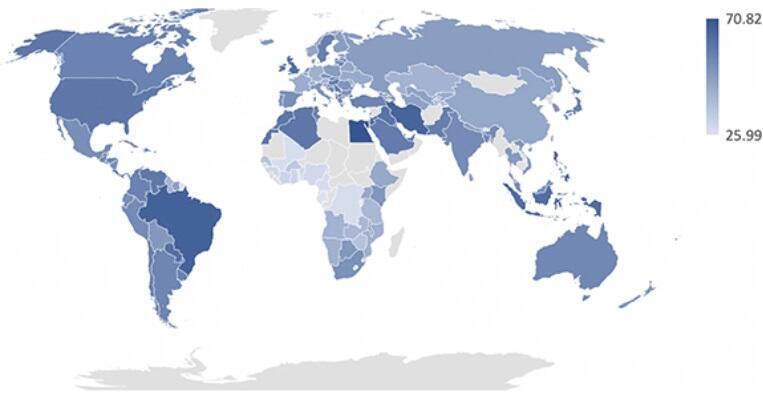The brain is a complex organ that controls bodily functions, cognitive abilities, emotions, and our general perception of reality. Diseases affecting brain functions can have a profound impact on our lives, disrupting them significantly.
Read more:
Consequently, numerous laboratories and research institutes worldwide are dedicated to studying the causes, mechanisms, and early indicators of these diseases. Particularly extensive research has been conducted in recent years on mental disorders, degenerative brain diseases, and developmental brain disorders.
4 View gallery


Many studies, even those that claim to be neutral, are conducted almost exclusively on male brains. Illustration of brain activity of a man and a woman
(Photo: Shutterstock)
While these diseases impact both men and women, much of the research, even that which claims to be gender-neutral, is predominantly conducted on male subjects. This gender bias was highlighted in an article recently published in the medical journal The Lancet, where female researchers from around the world analyzed the unique factors affecting women's brain health throughout their lives and how these factors are addressed in the world of scientific research.
They chose to focus the review on two diseases that affect women considerably more than men, Alzheimer’s and clinical depression, and conducted an in-depth examination of the level of consideration given in brain research to gender differences. The conclusions can be summed up in one word: disappointing.
Men are from Mars and women are from Venus
From a cultural and historical perspective, the debate regarding the difference between the female and the male brain is socially and emotionally charged. However, from a biological standpoint, there is no debate. Aside from their anatomical differences, there are significant differences between the sex hormones that are present in men and women, and these differences have profound effects on the development of brain-related diseases
Hormones are substances that are carried through the bloodstream, reaching multiple cells in the body and affecting their development and function. Most hormones in our body are present at similar levels in men and women.
However, those directly related to processes of sexual development and reproduction appear at different levels and at different times in each of the sexes, and the fluctuations in hormone levels also vary throughout the months and years. In men, as well as in males of other species, the primary sex hormone is Testosterone.
Testosterone levels are especially high during puberty and early adulthood, gradually decreasing throughout life, but remaining relatively high even in advanced age. Produced in the testicles in males, Testosterone plays a pivotal role in the development of male characteristics such as facial hair, a deep voice, and increased muscle mass. It is also essential for the production of sperm cells, and impairments in Testosterone production and levels are linked with male fertility issues.
4 View gallery


The primary sex hormone in men is Testosterone and in women it is Estrogen. The molecular structure of the hormones
(Photo: Shutterstock)
Women also produce Testosterone, albeit about 15 times less than men, and it affects women’s sexual development and behavior throughout their lives. In women, Testosterone levels in women peak around the age of twenty, gradually decreasing over the next two decades, and then stabilizing.
The main sex hormones in women are estrogen, mainly the types of Estrogen known as Estradiol and Progesterone. Produced mainly in the ovaries, their levels undergo significant fluctuations throughout a woman’s lifetime. Their levels rise during puberty, remain high during the reproductive years, with cyclical changes according to the menstrual cycle, surge during pregnancy, and decrease at the end of the reproductive period. The use of hormonal products, such as birth control pills or menopausal hormone therapy, also alters these hormonal fluctuations. Men also have Estrogen, albeit at levels, approximately ten times lower than in women, with levels remaining relatively stable after puberty.
Female sex hormones and their impact on the brain
It is now recognized that testosterone has extensive effects on brain structure and activity in both sexes. Among others, Testosterone is associated with learning, memory, and volumetric changes in different brain regions. In contrast, the impact of female sex hormones on the developing brain is far less well-understood.
In the female body estradiol and progesterone adjust and regulate the activity of the reproductive system, but they also have broader implications. For example, receptors to estradiol and progesterone are found in diverse nerve cells across the brain, implying that nerve cells can identify the hormones and react to their presence, and suggesting that these hormones influence areas related to learning, memory formation, and emotional regulation. Brain cells that recognize female sex hormones are located, among others, in areas linked to learning, forming memories, and emotional regulation. Consequently, the levels of these hormones are likely to have an impact on the female brain.
Even before the onset of the first menstruation, girls begin to experience a significant surge in sex hormones. This leads to physical changes, such as the growth of armpit and pubic hair, breast budding, rounding of the hips, weight gain, and changes in body odor. When the first period appears, it is sometimes irregular and it can take up to two years for the menstrual cycle to stabilize.
A woman experiences about 450 menstrual cycles during her lifetime, starting from around the age of 12 until her forties or fifties. Throughout this time, her body engages in a complex interplay of sex hormones production and regulation and their release into the bloodstream in a cyclical pattern of fluctuations. The sex hormones and their rising and declining levels are affected by one another, in a complex cycle of mutual regulation. Every month they lead to the development of follicles in the ovaries, from which an egg cell will eventually be released during ovulation and travel towards the fallopian tubes, where fertilization can occur with the help of a sperm cell. If the egg cell remains unfertilized it will be ejected, menstrual bleeding will occur, and the menstrual cycle will start anew.
4 View gallery


In a large study, most women reported experiencing at least one symptom of premenstrual syndrome, with 64% reporting mood swings or anxiety. Data on the prevalence of these symptoms in women in different countries
(Photo)
Hormonal fluctuations throughout the menstrual cycle are known to affect mood. A large study involving about 240,000 women from 140 countries, found that most women experience at least one premenstrual syndrome symptom in the days leading to menstrual bleeding, with 85% of the women reporting food cravings, 64% experiencing mood swings or anxiety, and 57% reporting fatigue.
When a woman becomes pregnant, the levels of sex hormones in her blood surge. These levels drop postpartum, leading to structural brain changes and altered behavior. Among other things, changes in a mother’s brain influence her brain’s response to the sight of babies.
When women approach menopause the amount of sex hormones in their bodies diminishes, and eventually, they stop menstruating. The drop in hormone levels causes significant changes in the body’s metabolism, the activity of the immune system, and more. This hormonal change, which has no parallel in men, can affect brain functions in some women. A study utilizing brain scans identified changes in the volume and activity of different brain areas during the period of menopause.
Biased Research
Even though women experience unique physical processes such as the menstrual cycle, pregnancy, and menopause, much of the current research conducted solely on men is deemed neutral, suggesting that the findings are universally applicable to women. This misconception stems from the flawed assumption that men represent the norm and, aside from different reproductive organs, women are similar to men in all other aspects. This perspective is not only inaccurate but also dangerous, as it has detrimental implications for the health of many women.
Studies have shown that recommended dosages for taking certain medications are often not adjusted for the female body. A study that examined this found that for dozens of drugs most of the drugs tested, their concentration in the blood was higher in women than in men, and also that in women it took a longer time to expel the drug from the body. In many of the drugs tested, the likelihood of side effects was higher in women compared to men. Regrettably, these physiological and hormonal differences may have led to incorrect diagnoses and less suitable treatments for women.
Much like the oversight in addressing gender differences in the field of drug development, a parallel issue exists in the world of research. Conditions such as Alzheimer’s and clinical depression are more prevalent in women, yet much of the relevant research fails to adequately account for gender differences. In some cases, research studies even fail to recruit women participants entirely.
A substantial number of mental disorders, including depression, anxiety, eating disorders, and post-traumatic stress disorder, are more prevalent in women, while addiction, schizophrenia, and antisocial personality disorder are more commonly diagnosed in men. However, only five percent of the studies conducted in the field of mental disorders in 2019 tested the impact of the subject’s gender on the research outcomes. Moreover, a study that reviewed dozens of articles examining the brain’s response to psychiatric drugs concluded that gender indeed influenced the outcomes in 72% of the cases in which this variable was taken into account.
Hormonal Fluctuations And Brain Diseases - Cause And Effect?
It seems that the described outcomes in women can be attributed, to some extent, to the fluctuating levels of sex hormones in their bodies. For instance, the risk of developing Alzheimer’s disease increases significantly after menopause. This increase is linked to a sharp decline in Estradiol levels characteristic of this age, potentially dropping by as much as ninety percent.
The decline in hormones may have far-reaching implications for a woman's brain. Early menopause, such as that resulting from the removal of ovaries, for example, is also associated with an increased risk of cognitive decline and depression. A main player in this context is the hippocampus, an area in the brain that significantly affects memory, and deficiencies in its activity are linked to depression and Alzheimer's. The hippocampus contains a large number of receptors or female sex hormones and thus may be affected by their dynamic fluctuations. An example of this is the variation in hippocampal volume and the activity of its nerve cells, which is correlated with the menstrual cycle.
The onset age of sexual development can also have a significant influence on brain health. For example, studies have found that later onset of menstruation (age 16 or older) is associated with an increased risk of Alzheimer’s in adulthood. However, this may not be a direct effect of the hormones on the brain, but rather an indirect effect of conditions such as obesity, diabetes, and vascular diseases, which are also related to hormonal activity and can contribute to the development of brain diseases later in life.
A unique factor that naturally affects women and not men is pregnancy. During pregnancy the levels of sex hormones in the female body increase, and this can have a tremendous effect on the risk of developing brain disease. In a study that examined human brains post-mortem, parameters linked to Alzheimer's disease showed that in women, but not in men, the severity of the disease correlated with the number of children the women have had. However, this association is far from clear. Another study found a link between the number of children and the likelihood of dementia in both women and men, suggesting that the documented effects may stem from environmental factors such as stress, not solely from the impact of sex hormones on the female brain.
Medicinal Hormonal Treatment
An important issue to consider is the hormonal effect of birth control pills. These pills are very popular and are currently taken by approximately 151 million women worldwide, which accounts for about sixteen percent of women of reproductive age. A 2019 survey conducted by Haaretz newspaper, indicated a lack of current data on the proportion of women taking these pills in Israel. As of 2006, a survey found that sixty-seven percent of women had taken birth control pills at some stage in their lives, with about thirty-one percent of women aged 25 to 34 reporting their use at the time.
4 View gallery


During pregnancy, the levels of sex hormones in the female body increase and this can significantly influence the risk of developing brain diseases. A pregnant woman with a graph illustrating progesterone levels during pregnancy
(Photo: Shutterstock)
Birth control pills contain a combination of female sex hormones, with one of their primary functions being the prevention of ovulation. The use of these pills significantly alters hormone levels and natural hormonal patterns of rise and fall. The prolonged use of these pills, potentially spanning decades, may influence both the structure and function of the brain.
A review of studies in the field presents conflicting findings regarding the effect of these pills on brain function and mental health. The authors suggest that these inconsistencies could stem from the considerable variation in formulations offered by different pill manufacturers. Hence, to gain a clearer understanding of the effects of the pills, it is also necessary to account for the varying hormone concentrations administered to participants.
Studies have found a link between prolonged use of birth control pills and improved cognitive function at later ages. It is challenging to precisely determine the relationship between the pills and protection from dementia, but it is likely a moderate and prolonged effect on brain activity. For instance, studies have shown that birth control pills affected the volume of certain areas in the brain, resulting in slightly altered brain activity during the performance of tasks that are related to working memory, which is the memory we use to hold a small amount of information for a short time, to perform more complex tasks, such as dialing a new phone number.
Alternative hormonal treatments that many women take during menopause can also affect brain activity. A study conducted in Brazil found that twenty percent of women received hormonal treatment during menopause. It is still unclear whether these medicines aid or harm brain health, and it seems that the story is complicated. While in some cases they can provide the brain with protection from degeneration and help against depression, other studies demonstrate that using them at a later age can increase the risk of dementia.
Planning Ahead
Men and women are similar in many aspects, and many conclusions from studies conducted on one's brain will be relevant to the other. However, we must not forget the differences, and it is imperative to address them in the planning of research or medical treatments. We need brain research that puts the issue of gender differences at the forefront and characterizes both the conditions unique to women and the treatments that will benefit them most.
In addition, large databases are required that contain data from different studies and enable meticulous examination of the female brain, apart from the male brain. Raising awareness and securing funding for research in this field is of paramount importance for enhancing our understanding of these important issues.

